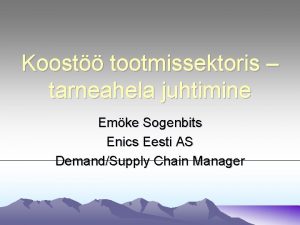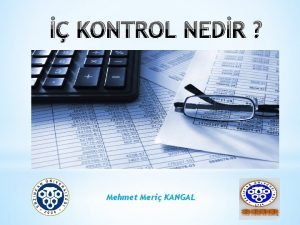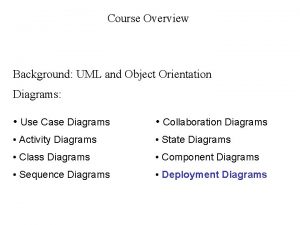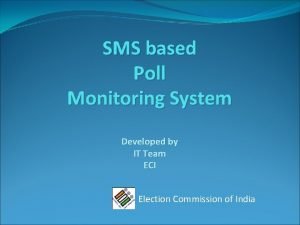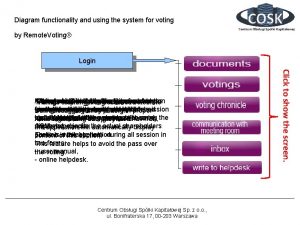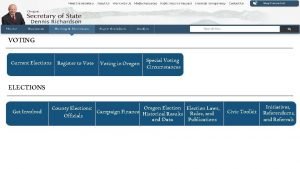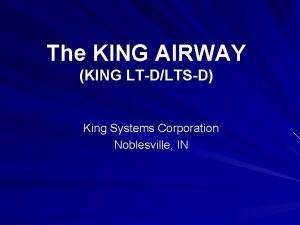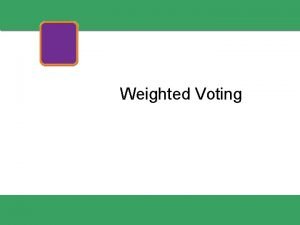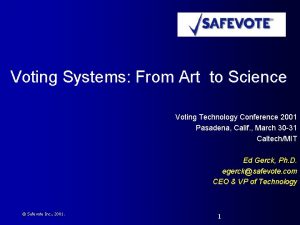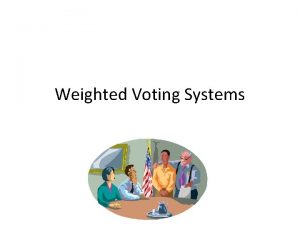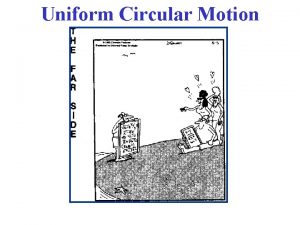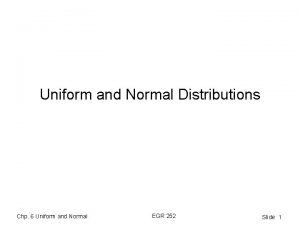Uniform Voting Systems Merle S King January 11




































- Slides: 36

Uniform Voting Systems Merle S. King January 11, 2013 Denver, CO © 2011

Disclaimer(s) • Employed by Kennesaw State University • Do not represent State of Georgia or the Office of the Secretary of State of Georgia • Do not represent the EAC • Opinions expressed are my own

The Georgia Experience • 2000 Election in Georgia • 94 K “Spoiled Ballots” • 20% “spoiled” in one county • 2001 “ 21 st Century Commission • Two recommendations • Uniform Voting System • DRE based • 2001 municipal elections used for 9 pilots • Contract let in May 2002.

The Georgia Experience • $54 M initial outlay • Two counties used in July primary • Rest of the state in November 2002 election • Statewide vendor support during first statewide election • Added electronic pollbooks in 2005 • Added bar code scanners in 2009 • Multiple version updates

Election Official as IT Manager • Attitude • Knowledge • Skill What are the core competencies of election officials?

Election Official as IT Manager • Attitudes – – – IT is an investment IT goals must be congruent with organization goals IT is pervasive and creates dependencies IT is not a capital asset; it’s “supplies” Vendor partnerships necessary; vendor management mandatory – IT leadership is a meritocracy – Youth will be served

Election Official as IT Manager • Knowledge – – Must understand core technologies Must understand system dependencies Must be able to plan IT Must understand IT audit principles • Skills – Consider ROI of personal skills – Cultivate, delegate, sub contract

Innovation • What are some of the features that states and localities are looking for in a “next generation” voting system? – – – backward/forward compatibility true cost of ownership defined horizontal & vertical integration long service life adaptive multi-mode

Innovation • How could the next generation of equipment make voting – and election administration – more efficient? – data collection and reporting – non-invasive security diagnostics – appropriate vendor roles – auditability

Emerging Challenge In the future, we may not be able to separate the consequence of poorly performing election systems from well performing voting systems.

Systems • A system is a collection of components (including subsystems) that transform inputs into outputs. • Systems utilize feedback loops to monitor states and adjust performance • Systems maintain interfaces with other systems

System Components • • • Hardware Software Data People Procedures

Voting Systems • Vote Capture • Vote Tabulation

Election Systems used to collect, store, compute, analyze, report, and disseminate data related to the election process. Includes voter registration, digital pollbooks, ballot delivery and retrieval, election night reporting, voting systems, social media systems, etc.

Uniform Voting System • Uniformity of voting systems is multi-dimensional. Within the jurisdiction there may be uniformity in – – Technologies Vendor (single-vendor) Procedures Administrative organization • Uniformity enhances standards; standards are the metrics of quality enhancement

Uniform Voting System • A voting system that consists of a defined set of vote-capture and vote-tabulation devices, consistent procedures applied across all jurisdictions, defined roles for participants in the administration of elections and standard and consistent formats for election data and the management of that data • Uniformity is already imposed by statute or rule on many aspects of voting and election systems • Uniformity is a matter of degree

Uniform Voting System • There are no single-vendor systems • Every voting system is a collection of proprietary, COTS and integrated sub systems which have multiple vendors (consider the supply chain for consumables) • At best, a “single vendor” is an integrator • Vendor dependency: the vendor is a portal to the jurisdiction’s voting and election systems

Uniform or Unified? Are jurisdictions moving toward uniformity or unification of election systems?

Emerging Systems Voter Registration Systems • Online VR Systems • Online VR Application Systems • VR Reporting Systems • Integration with GIS

Emerging Systems Election Reporting Systems • Statewide rollup • County/Township/ Precinct level reporting • Post election analysis • Data harvesting potential • Integration with GIS

Emerging Systems • Vote-by-mail • UOCAVA Ballot Delivery Systems • Internet Voting • Social Media Distributed Voting Technologies

Emerging Systems • Ballot on Demand • Electronic Pollbooks • Voter ID initiatives • Accessibility Enhancements • Security Enhancements • Training & Outreach Operations Enhancement

Mature Systems • VVSG standard exists • Testing protocols are established and vetted • Local focus with some State level control • Legacy issues • Oldest technologies; mature market Voting System Vote Capture/Vote Tabulation

System Convergence Voter Registration Systems Election Reporting Systems Distributed Voting Technologies Voting System Vote Capture/Vote Tabulation Operations Enhancement

Unified Election System Voter Registration Systems Election Reporting Systems Distributed Voting Technologies Voting System Vote Capture/Vote Tabulation Operations Enhancement

Advantages of a statewide, uniform voting system • The process and outcome of the needs assessment will illuminate unrecognized inefficiencies in your current system(s) • The implementation of a uniform voting system requires the state to “clean up” conflicting, ambiguous, and unnecessary sections of the code and rules • The transition becomes a tipping point where past and future relationships are evaluated and affirmed or reformulated • Quality – “The standard of something as measured against other things of a similar kind; the degree of excellence of something”. Quality requires standards.

Advantages of a statewide, uniform voting system • Training programs can be economically developed and delivered to: • Election officials • Poll managers • Poll workers • Voters The entire state is being trained to implement a single set of procedures. In a highly mobile population, this increases the effectiveness of election administrators and the effectiveness of voters moving within the state

Advantages of a statewide, uniform voting system • Small counties receive the same consideration and quality of service as large counties • Integration of new products and innovations into the existing system is better planned, tested and controlled • Disaster recovery and election continuity plans can leverage personnel and resources from surrounding counties • Career paths for election administrators are broadened. Recruiting from within state becomes easier • Communication to voters on critical issues is managed centrally – one message; no confusion

Advantages of a statewide, uniform voting system • Research on anomalies can be centrally coordinated and resulting message is fast, accurate and relevant • Economies of scale exist for negotiating services • Vendor contracts are negotiated at the state/AG level – not with a county attorney and county procurement office • Opportunities exist to create a firewall between vendors/products and the jurisdiction • EMS support becomes doable • Centralized ballot building becomes doable • Emergency ballot printing becomes doable

Advantages of a statewide, uniform voting system • Jurisdictions can shift from exception handling/mitigation to more strategic planning • Interface with VR system is simplified • State Certification and State Acceptance Testing models become more doable

Disadvantages of a statewide, uniform voting system • Retirements • Election officials • Poll managers • Poll workers • Shared vulnerability • Lack of flexibility • Inertia • Unless well-managed, entire states rather than just counties can become captive to a vendor

Things to consider • Define evaluation criteria early. How will success (failure) be measured? • Define vendor role. What are the expectations for the vendor(s)? How will they be enforced? • Determine what portions will be managed bottom-up and what portions, top-down

Things to consider • Define the stakeholders – their roles and their expected contribution to the project. Participants must contribute • Beware of scope creep. Define the boundaries of the project, validate them and stick to them • Develop a strong RFP

Things to consider • Timelines have to reflect election calendars. What is the optimal time to implement? • Management of ECOs, maintenance and testing should be addressed – especially acceptance testing • Ballot building and services

Things to consider • Training is single most important control • Retirement of current systems; disposal of new system • Audit program of vendor performance and compliance • Communication

Questions? Merle King mking@kennesaw. edu
 Dr merle martin
Dr merle martin Merle crawford
Merle crawford Dr merle rust
Dr merle rust Merle sepp
Merle sepp Romantism
Romantism Bouvreuil brun
Bouvreuil brun Merle parmak
Merle parmak Dr merle martin
Dr merle martin Skisoidne isiksus
Skisoidne isiksus Emöke sogenbits
Emöke sogenbits Merle kangal
Merle kangal A data flow diagram (dfd) is composed of which elements
A data flow diagram (dfd) is composed of which elements Neuroimaging
Neuroimaging How do you classify uniform and non-uniform mixtures?
How do you classify uniform and non-uniform mixtures? Types of mixtures
Types of mixtures Contoh aliran seragam
Contoh aliran seragam Type of motion
Type of motion Imf functions
Imf functions Higher modern studies voting behaviour essay
Higher modern studies voting behaviour essay Voting rights
Voting rights Voting by feet tiebout
Voting by feet tiebout Hough voting
Hough voting Formal culture region differs from other regions in that it
Formal culture region differs from other regions in that it Sociological factors that affect voting behavior
Sociological factors that affect voting behavior Deployment diagram notations
Deployment diagram notations Block diagram of mobile phone
Block diagram of mobile phone Brainpop political parties
Brainpop political parties Sms based poll monitoring system
Sms based poll monitoring system Online voting system project proposal
Online voting system project proposal Hough voting
Hough voting Activity diagram for online voting system
Activity diagram for online voting system Which statement best summarizes the soldier's thoughts
Which statement best summarizes the soldier's thoughts Red line voting
Red line voting Meetoo voting
Meetoo voting Polling with vevox
Polling with vevox Ieee ou analytics
Ieee ou analytics Pros of fptp
Pros of fptp









